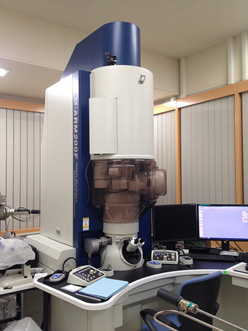Press Releases
JAMSTEC
Hiroshima University
Discovery of Natural MgSiO3 Tetragonal Garnet
in Shocked Chondritic Meteorite
- A new clue to explore asteroidal impact events and Earth's mantle mineralogy -
Overview
A research team of Dr. Naotaka Tomioka and Dr. Motoo Ito at the Kochi Institute for Core Sample Research, the Japan Agency for Marine-Science and Technology (JAMSTEC: Asahiko Taira, President), and Dr. Masaaki Miyahara at Hiroshima University discovered a unique garnet, which could be formed only under ultrahigh pressure, in a stony meteorite.
MgSiO3-pyroxene, which is a major constituent mineral of the Earth's crust and mantle, transforms into higher density phase called “tetragonal garnets” at 16–22 GPa and 1600–2400°C as reported in the mid-1980's based on laboratory experiments. However, such a garnet had not been found in nature.
The research team examined a heavily shocked meteorite fell in Australia in 1879, which has experienced high-pressure and high-temperature conditions by an impact event on its parent body, based on transmission electron microscopy (TEM)*1 at the Kochi Institute for Core Sample Research. As a result, they identified natural MgSiO3 tetragonal garnet first in the world. The garnets are deduced to have formed at 1900–2000°C and 17–20 GPa, and the cooling rate of shock-induced melt vein containing the tetragonal garnet is estimated to have been larger than 1,000°C per second.
Ultrahigh-pressure minerals including tetragonal garnet are keys to understand fundamental parameters in the early solar system such as physical properties of small bodies and their relative collision velocities. As they are thought to exist also in the Earth's mantle, they would significantly contribute to elucidating mineralogy and physical properties of deep Earth. The research team will further carry out more detailed analyses of mineralogy and chemistry of various kinds of shocked meteorites to clarify environmental changes on the surface of asteroids.
The above results were published on Science Advances by the American Association for the Advancement of Science on March 26, 2016 (JST). This work was carried out as part of the partnership agreement between Kochi Institute for Core Sample Research, JAMSTEC and Graduate School of Science, Hiroshima University, and was supported by JSPS KAKENHI Grant Number 15H03750.
Title: Discovery of natural MgSiO3 tetragonal garnet in a shocked chondritic meteorite
Authors: Naotaka Tomioka1, Masaaki Miyahara2, Motoo Ito1
1. Kochi Institute for Core Sample Research, JAMSTEC
2. Department of Earth and Planetary Systems Science, Graduate School of Science, Hiroshima University
*1 TEM (transmission electron microscope) is a type of electron microscope, in which an electron beam is transmitted through ultra-thin samples interacting with the specimen as it passes through it. With TEM, we can evaluate crystal structures using electron diffraction, microstructures using diffraction contrast imaging, and chemical compositions using energy-dispersive X-ray spectroscopy (EDS).


Figure 1. Pressure-temperature phase diagram of MgSiO3 (modified from Gasparik, 1990) Pyroxene (enstatite) transforms into the tetragonal garnet phase, ilmenite phase and perovskite phase with increasing pressure at high temperature. The red broken line indicates the liquidus curve of bulk chondrites. The blue-colored area represents the estimated pressure-temperature conditions of the formation of (Mg,Fe)SiO3 tetragonal garnet in Tenham.

Figure 2. Crystal structures of cubic and tetragonal garnets
Oxygen anions are located on the corners of the polyhedrons. The normal garnet structure belongs to the cubic system, which has only aluminum cations in the six-coordinated site (octahedra shown in blue). In the tetragonal garnet structure, the six-coordinated site is split into two different sites: those with magnesium cations (shown in green) and with silicon cations (shown in light blue). The site splitting causes tetragonal distortion from the cubic unit cell (c-axis is slightly shrunk).

Figure 3. A thin section sample of the Tenham meteorite
Black veins (shock-induced melt veins) are observed throughout the sample. The sample is 21mm wide.

Fig. 4. Back-scattered electron image of a shock-induced melt vein in the Tenham chondritic meteorite. Fragments of minerals of the host rock are captured in the shock vein. Olivine grains Mg2SiO4 in a fragment at the center of the image were transformed into the spinel phase (Sp). Pyroxene (Px) is partly transformed into the tetragonal garnet phase. The rectangular hole is a portion extracted by a focused ion beam apparatus (FIB) for TEM analysis.

Figure 5. Polarized optical micrographs of a fragment of host rock captured in a shock-induced melt vein. (Upper) Open Nicol image; (Bottom) crossed Nicols image. The portion of garnet in the rim of a pyroxene grain is seemingly optically isotropic owing to very small tetragonal distortion from cubic symmetry. The surface of the left part of the garnet aggregate was processed to be an ultrathin foil by FIB.

Fig. 6. Transmission electron micrograph of an aggregate of MgSiO3 tetragonal
garnet in Tenham. The garnet grains were formed by high-pressure transformation of MgSiO3 pyroxene in its host rock.

Figure 7. Electron diffraction pattern from a single crystal of tetragonal garnet. Each spot corresponds to diffraction from a particular crystallographic plane (Numbers are indices of crystallographic planes). The weak reflections indicated by triangles in the right figure were caused by tetragonal distortion from the cubic garnet structure.
Contacts:
- (For this study)
- Naotaka Tomioka, Senior Research Scientist, Kochi Institute for Core Sample Research, JAMSTEC
- (For press release)
- Hiroyasu Matsui, Press Division, Public Relations Department, JAMSTEC
- Garin Son, Public Relations Group, Office of Academic Research and Industry-Academia-Government and Community Collaboration, Hiroshima University
